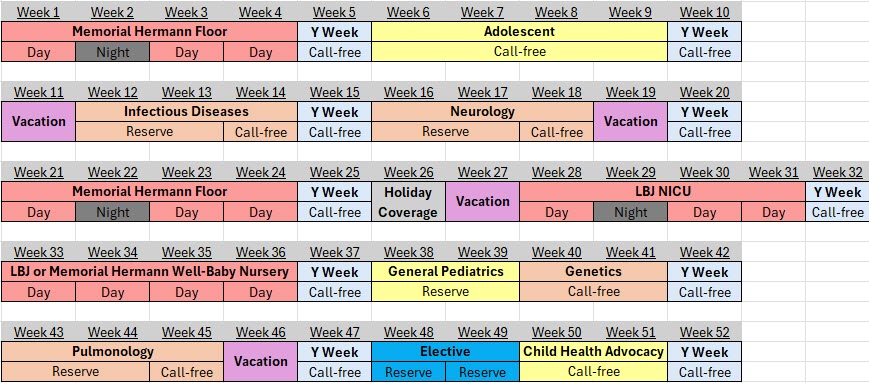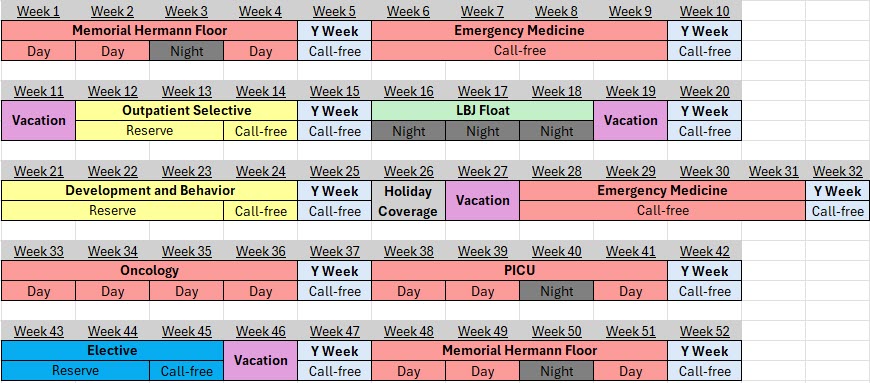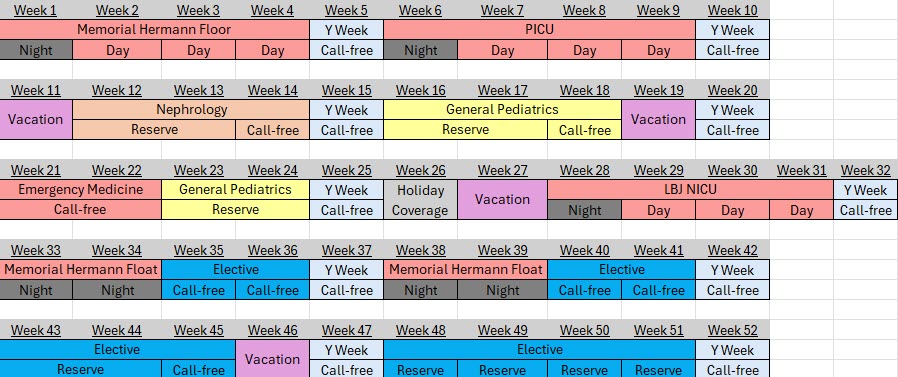Year-by-Year Preview
The X+Y in action
Rotations will switch on Mondays and are broken into weeks, not based on calendar month. All rotations are generally two to four weeks in length. The schedules below are examples of what each resident can expect to be assigned as well as how often residents can expect to be on nights and reserve shifts. Around the December/January holiday season, residents are usually given one week off and assigned another week to help provide staffing for essential services.
This key provides the context for each color-coded block in the sample schedules that follow:

Postgraduate Year 1 (PGY-1)
The first year of residency or “intern year” consists of establishing an understanding of both normal and pathologic pediatric physiology. This year will include rotations on the general inpatient pediatric floor and intermediate medical unit (IMU) at Children’s Memorial Hermann; well-baby nursery and Level III NICU at LBJ Hospital. During the general inpatient months, interns will always have an upper-level resident or attending who will help provide supervision as interns learn how to clinically manage a variety of patient ages and conditions. All interns participate in a child-health advocacy rotation where they will gain a better understanding of the numerous issues affecting the health of our patients as well as the resources available to help children and families.
During intern year, residents also rotate on subspecialties such as neurology, infectious diseases, adolescent medicine, pulmonary medicine, and genetics, where residents work on a team with other residents and learn from the subspecialty faculty and fellows. During these subspecialty rotations, residents will perform inpatient consults and have the opportunity to attend subspecialty clinics if the resident wishes to have that experience.
Example of a PGY-1 Pediatric Resident Schedule

Postgraduate Year 2 (PGY-2)
The second year of residency consists of reinforcing the objectives of the first year while simultaneously introducing higher complexity patient care as well as the supervisory role of a resident-teacher.
On the pediatric Floor, the upper-level resident is responsible for leading the team of residents and students and managing the care for their patients. A typical schedule includes day shifts and night shifts where residents oversee the management of their pediatric patients from admission to discharge while ensuring interns also receive appropriate supervision.
Upper-level residents will also work in the PICU, where they manage higher-acuity patients as part of a team with other senior residents, fellows, and faculty. PGY-2 residents will also start emergency medicine rotations, where they master triaging and managing patients in the Children’s Memorial Hermann Emergency Department (ED) that also works with the Level I Trauma Center of Memorial Hermann.
PGY-2 residents will also spend time in various subspecialty clinics, including outpatient cardiology and development clinics, to gain a better understanding of the different services to which they will refer patients.
Example of a PGY-2 Pediatric Resident Schedule

Postgraduate Year 3 (PGY-3)
The third (and final!) year of residency is designed to ensure residents are comfortable and confident in their chosen career paths after residency, whether it be general pediatrics or a subspecialty fellowship.
On the pediatric floor, the resident will continue to lead a team of residents and students as they are given more independence by their supervising faculty. Third-year residents will also be scheduled to work “float weeks” in Children’s Memorial Hermann where they will have more supervisory experiences while in the hospital overnight.
During this year, residents have multiple elective months that are unique to each resident. Available electives range from advocacy, global health, medical education and every possible pediatric subspecialty to help prepare all residents for the next stage of their career.
Example of a PGY-3 Pediatric Resident Schedule

Vacation
Our categorical pediatrics residents are given four weeks of total vacation throughout each academic year. Each vacation must be taken as an entire week off. Residents are free to schedule three of their weeks whenever they wish. The fourth week is generally reserved around the December holiday season when staffing is reduced.